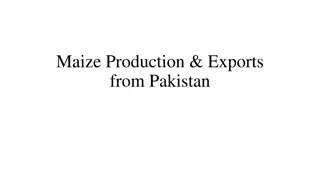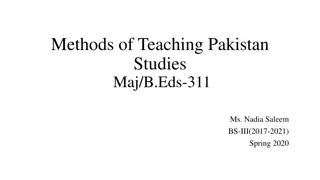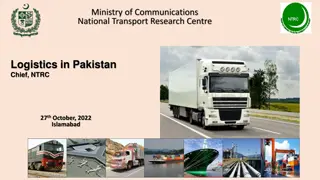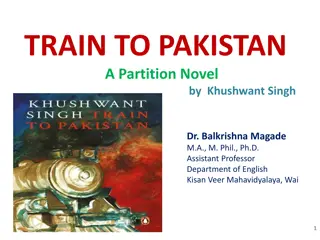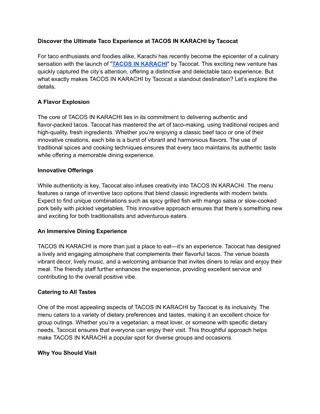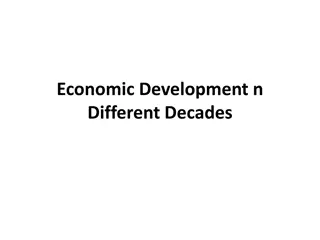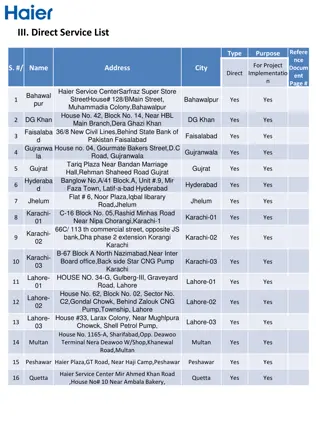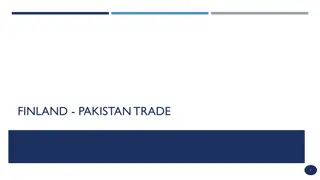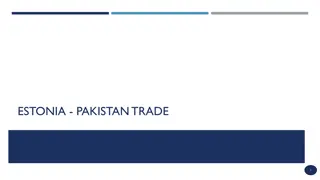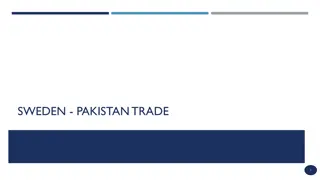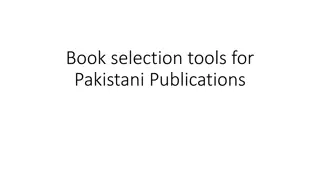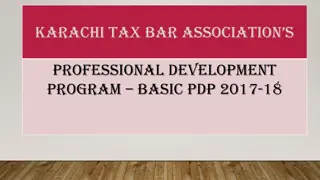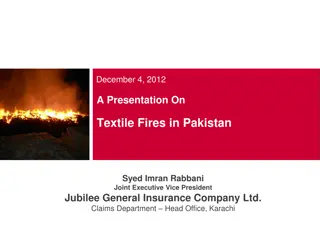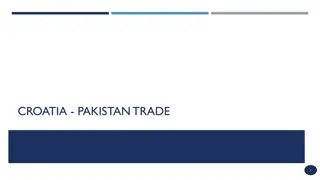Exploring the Economic Impact of CPEC in Karachi and Pakistan
Delve into the comprehensive analysis of the China-Pakistan Economic Corridor (CPEC) and its implications on Karachi's development, featuring insights from Dr. Nadeem Javaid, Chief Economist of the Government of Pakistan. Discover the strategic cooperation fields, industrial zones, developmental targets, and myriad opportunities offered by CPEC, as well as the population trends in Pakistan from 1951 to 2017.
Download Presentation

Please find below an Image/Link to download the presentation.
The content on the website is provided AS IS for your information and personal use only. It may not be sold, licensed, or shared on other websites without obtaining consent from the author. Download presentation by click this link. If you encounter any issues during the download, it is possible that the publisher has removed the file from their server.
E N D
Presentation Transcript
Leveraging CPEC Karachi Dr Nadeem Javaid Chief Economist, Government of Pakistan
Sequence of talk CPEC Census 1951-2017 City Competitiveness Leveraging Karachi, Way Forward !!!
CPEC Cooperation Fields China Pakistan Economic Corridor Long Term Plan : Timeframe 2014 2030 Components: I. Energy (Coal, Hydel, Wind, Solar, LNG , Transmission) II. Infrastructure (Road, Rail, Aviation, Data connectivity) III. Gwadar Port (Socio-economic development) IV. Industrial Cooperation (Gwadar Free Zone and other industrial parks to be finalized) Framework: Joint Cooperation Committee supported by 5 Joint Working Groups is steering the program.
Development Targets 1st Target cultivation. To develop commercial logistics and other industries with local resources. 2020 : Period of market 2nd Target expansion Processing industries will be developed. 2025 and and : Period of development. manufacturing 3rd Target Maturity. Enlarge the scale and scope of Free Zone. 2030 : Period of
Industrial Cooperation under CPEC 9 Location for Industrial Zone (6th JCC) Province/Unit KPK Rashakai Economic Zone Sindh Dhabeji Balochistan Bostan Industrial Zone Punjab M-2 Sheikhupura North Area Moqpondass, Gilgit Baltistan SEZ Federal Area ICT Model Industrial Zone & PSM-Port Qasim FATA Mohmand Marble City AJK Bhimbar Industrial Zone
Opportunities Agriculture, Food processing Mines & Minerals Electronics, Light Engineering, Chemicals, Automobiles etc. Textiles Energy Sector (Oil & Gas Exploration) Construction 6
Connectivity and Wider Economic Benefits Economic Corridor Transport Corridor 7
Population of Pakistan Population of Pakistan (in millions) (Census 1951-2017) (in millions) 207.8 170.1 132.4 108.3 84.3 65.3 42.9 33.7 1951 1961 1971 1981 1991* 1998 2010* 2017 *= estimated to fill the gap
Population by Residence Population by Residence Census (1951-2017) 17.7 22.5 25.4 28.3 32.5 36.4 Urban 82.3 77.5 74.6 71.7 67.5 63.6 Rural 1951 1961 1972 1981 1998 2017
Top cities of Pakistan Top cities of Pakistan (Census 1951-2017) City Rank 1951 1961 1972 1981 1998 2017 1 Karachi Karachi Karachi Karachi Karachi Karachi 2 Lahore Lahore Lahore Lahore Lahore Lahore 3 Hyderabad Hyderabad Faisalabad Faisalabad Faisalabad Faisalabad 4 Rawalpindi Lyallpur Hyderabad Rawalpindi Rawalpindi Rawalpindi 5 Multan Multan Rawalpindi Hyderabad Multan Gujranwala 6 Lyallpur Rawalpindi Multan Multan Hyderabad Peshawar 7 Sialkot Peshawar Gujranwala Gujranwala Gujranwala Multan 8 Peshawar Gujranwala Peshawar Peshawar Peshawar Hyderabad 9 Gujranwala Sialkot Sialkot Sialkot Quetta Islamabad 10 Quetta Sargodha Sargodha Sargodha Islamabad Quetta
Population of Pakistan, Population of Pakistan, (Future Projections 2051 based on Census 2017) 450.0 416.2 400.0 391.5 350.0 326.3 300.0 In Millions 264.2 250.0 207.8 200.0 170.1 150.0 132.4 108.3 100.0 84.3 65.3 50.0 42.9 33.7 0.0 1951 1961 1971 1981 1991* 1998 2010* 2017 2027 2037 2047 2051
Population of Pakistan, Population of Pakistan, (Future Projections 2051 based on Census 2017) 450.0 416.2 400.0 * In next 30 years population will be doubled, 391.5 Pakistan 14th largest in 1951, 7th in 1990, 6th in 350.0 326.3 2017, 300.0 In Millions ** and remain 6th till 2050 (Thanks to Nigeria) 264.2 250.0 207.8 200.0 170.1 150.0 132.4 108.3 100.0 84.3 65.3 50.0 42.9 33.7 0.0 1951 1961 1971 1981 1991* 1998 2010* 2017 2027 2037 2047 2051
Poverty- Cost of Basic Need (Headcount) 80 70 60 % Population 50 40 30 20 10 0 1998-99 2001-02 2004-05 2005-06 2007-08 2010-11 2011-12 2013-14 57.9 64.3 51.7 50.4 44.5 50 37.3 36.6 63.4 70.2 58.4 57.4 National Urban Rural 44.1 32.7 49.7 36.8 26.2 42.1 36.3 22.8 43.1 29.5 18.2 35.6
GDP Growth Trend (%) 6.5 6.0 6.0 5.3 5.5 5.0 4.5 4.5 4.1 4.1 3.8 3.7 4.0 3.5 3.0 2011-12 2012-13 2013-14 2014-15 2015-16 2016-17 2017-18 (Target) Data Source: PBS & Planning Commission
Emerging Middle Class Emerging Middle Class Consumer Market is growing Poverty levels have declined Middle Class is Emerging ( 80 Million ) 15
Housing Units - Shortage Population growth, the continuing trend toward urbanization, and rising incomes are all fueling the increasing demand for housing. There is 10 Million Housing Units shortage, i.e. further accumulating by 0.34 million units every year !! Formal financial sector caters only up to 2 % of all housing transactions, the lowest ratio in the region (10-12% is catered by Informal Sector)
Consumer Expenditure on Housing (% of Total Household Expenditure) 21 Lahore 19.2 Karachi 23.1 New York 13 Mumbai 17.7 Seoul 16.6 Shanghain 13.5 Shanghai 40 Dubai 0 5 10 15 20 25 30 35 40
How to cater the needs of society? Horizontal growth is untenable, going vertical is the suitable option; Economies of Scale Affordability Short Commuting Facilitate Social Mobility Making cities competitive - developing civic infrastructure compatible with Environment . Coherent town planning with a Master Plan for City s Development. (water, sewage, gas, electricity, firefighting, parking, Transport nods and pedestrian-friendly)
Cities as engine of economic growth - Better Urban Policy Density : Double edge agglomeration economies; The benefits of spatial concentration include the reduction of transport costs for goods, people, and ideas. spatial proximity; For millennia, cities have had to deal with the negative consequences of density, which include contagious disease, crime, and congestion.
Competitive Cities Look Like Accelerated economic growth. The top 10 percent of cities achieved 13.5 percent annual gross domestic product (GDP) per capita growth, compared with 4.7 percent in an average city; Outstanding job growth. The top 10 percent of cities achieved 9.2 percent annual jobs growth, compared with 1.9 percent in the remaining 90 percent. Increased incomes and productivity. The top 10 percent of cities increased the average disposable income of their households by 9.8 percent annually. Magnets for foreign direct investment (FDI). The top 5 percent of cities obtained as much FDI as the bottom 95 percent of cities combined.
Leveraging Karachi Way Forward !!! Finding the new land; Intensified / Efficient urban land use a) Damaging Agriculture b) Deforestation Karachi have to remove the barriers; a) Regulations promoting rent-seeking b) Over-restrictive building codes c) Zoning laws Incentivizing efficiency and innovation (an inclusive approach) The construction industry needs to evolve; d) a) Opaque marketplace (Informality and corruption) b) Poor project management and design processes, c) A lack of investment in technology, R&D, and workforce skills
Leveraging Karachi Way Forward !!! 4) Governments, (K. City) and Construction Industry urgently need to collaborate for improving the residents quality of life and ensure that housing shortages do not become a drag on economic growth. 5) Optimal degree of federalism/provincialism to carve appropriate policies, and the use of engineering and economics approaches to reducing the negative consequences of density.



